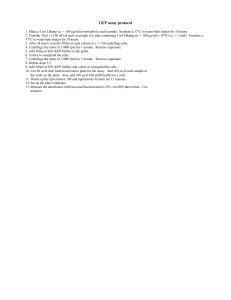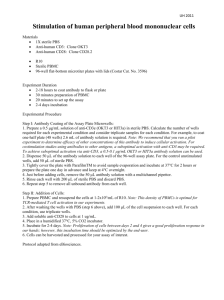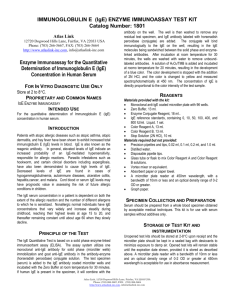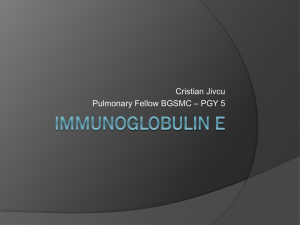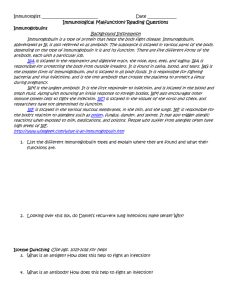Human IgE Antigen ELISA Kit Catalog # HUIGEKT Strip well format
advertisement
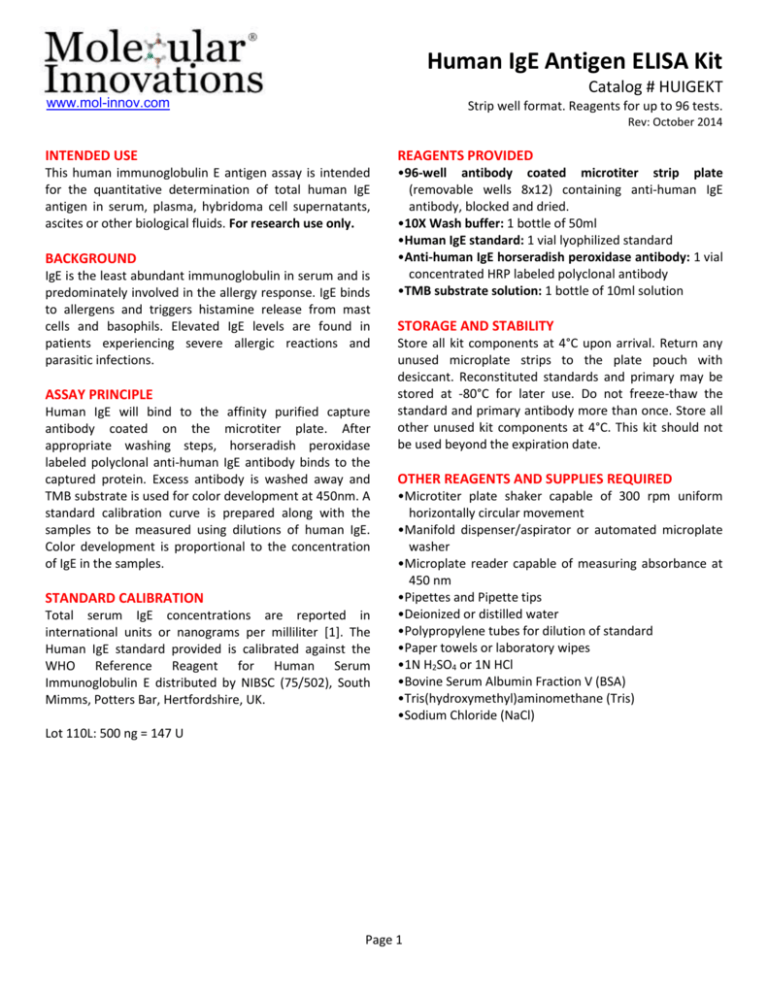
Human IgE Antigen ELISA Kit Catalog # HUIGEKT www.mol-innov.com Strip well format. Reagents for up to 96 tests. Rev: October 2014 INTENDED USE REAGENTS PROVIDED This human immunoglobulin E antigen assay is intended for the quantitative determination of total human IgE antigen in serum, plasma, hybridoma cell supernatants, ascites or other biological fluids. For research use only. •96-well antibody coated microtiter strip plate (removable wells 8x12) containing anti-human IgE antibody, blocked and dried. •10X Wash buffer: 1 bottle of 50ml •Human IgE standard: 1 vial lyophilized standard •Anti-human IgE horseradish peroxidase antibody: 1 vial concentrated HRP labeled polyclonal antibody •TMB substrate solution: 1 bottle of 10ml solution BACKGROUND IgE is the least abundant immunoglobulin in serum and is predominately involved in the allergy response. IgE binds to allergens and triggers histamine release from mast cells and basophils. Elevated IgE levels are found in patients experiencing severe allergic reactions and parasitic infections. ASSAY PRINCIPLE Human IgE will bind to the affinity purified capture antibody coated on the microtiter plate. After appropriate washing steps, horseradish peroxidase labeled polyclonal anti-human IgE antibody binds to the captured protein. Excess antibody is washed away and TMB substrate is used for color development at 450nm. A standard calibration curve is prepared along with the samples to be measured using dilutions of human IgE. Color development is proportional to the concentration of IgE in the samples. STANDARD CALIBRATION Total serum IgE concentrations are reported in international units or nanograms per milliliter [1]. The Human IgE standard provided is calibrated against the WHO Reference Reagent for Human Serum Immunoglobulin E distributed by NIBSC (75/502), South Mimms, Potters Bar, Hertfordshire, UK. STORAGE AND STABILITY Store all kit components at 4°C upon arrival. Return any unused microplate strips to the plate pouch with desiccant. Reconstituted standards and primary may be stored at -80°C for later use. Do not freeze-thaw the standard and primary antibody more than once. Store all other unused kit components at 4°C. This kit should not be used beyond the expiration date. OTHER REAGENTS AND SUPPLIES REQUIRED •Microtiter plate shaker capable of 300 rpm uniform horizontally circular movement •Manifold dispenser/aspirator or automated microplate washer •Microplate reader capable of measuring absorbance at 450 nm •Pipettes and Pipette tips •Deionized or distilled water •Polypropylene tubes for dilution of standard •Paper towels or laboratory wipes •1N H2SO4 or 1N HCl •Bovine Serum Albumin Fraction V (BSA) •Tris(hydroxymethyl)aminomethane (Tris) •Sodium Chloride (NaCl) Lot 110L: 500 ng = 147 U Page 1 PRECAUTIONS •FOR LABORATORY RESEARCH USE ONLY. NOT FOR DIAGNOSTIC USE. •Do not mix any reagents or components of this kit with any reagents or components of any other kit. This kit is designed to work properly as provided. •Always pour peroxidase substrate out of the bottle into a clean test tube. Do not pipette out of the bottle as contamination could result. •Keep plate covered except when adding reagents, washing, or reading. •DO NOT pipette reagents by mouth and avoid contact of reagents and specimens with skin. •DO NOT smoke, drink, or eat in areas where specimens or reagents are being handled. PREPARATION OF REAGENTS •TBS buffer: 0.1M Tris, 0.15M NaCl, pH 7.4 •Blocking buffer (BB): 3% BSA (w/v) in TBS •1X Wash buffer: Dilute 50ml of 10X wash buffer concentrate with 450ml of deionized water SAMPLE COLLECTION Collect plasma using EDTA or citrate as an anticoagulant. Centrifuge for 15 minutes at 1000xg within 30 minutes of collection. Assay immediately or aliquot and store at ≤ 20°C. Avoid repeated freeze-thaw cycles. ASSAY PROCEDURE Perform assay at room temperature. Vigorously shake plate (300rpm) at each step of the assay. Preparation of Standard Reconstitute standard by adding 1ml of blocking buffer directly to the vial and agitate gently to completely dissolve contents. This will result in a 500ng/ml standard solution. Dilution table for preparation of human IgE standard: IgE concentration Dilutions (ng/ml) 500 From standard vial 200 600µl (BB) + 400µl (500ng/ml) 100 500µl (BB) + 500µl (200ng/ml) 50 500µl (BB) + 500µl (100ng/ml) 20 600µl (BB) + 400µl (50ng/ml) 10 500µl (BB) + 500µl (20ng/ml) 5 500µl (BB) + 500µl (10ng/ml) 2 600µl (BB) + 400µl (5ng/ml) 1 500µl (BB) + 500µl (2ng/ml) 0.5 500µl (BB) + 500µl (1ng/ml) 500µl (BB) Zero point to 0 determine background NOTE: DILUTIONS FOR THE STANDARD CURVE AND ZERO STANDARD MUST BE MADE AND APPLIED TO THE PLATE IMMEDIATELY. Standard and Unknown Addition Remove microtiter plate from bag and add 100µl IgE standards (in duplicate) and unknowns to wells. Carefully record position of standards and unknowns. Shake plate at 300rpm for 30 minutes. Wash wells three times with 300µl wash buffer. Remove excess wash by gently tapping plate on paper towel or kimwipe. NOTE: The assay measures human IgE antigen in the 0.5-500 ng/ml range. If the unknown is thought to have high IgE levels, dilutions may be made in blocking buffer. A 1:10 dilution for normal human plasma is suggested for best results. Antibody Addition Briefly centrifuge vial before opening. Dilute 2µl of conjugated antibody in 10ml of diluent and add 100µl to all wells. Shake plate at 300rpm for 30 minutes. Wash wells three times with 300µl wash buffer. Remove excess wash by gently tapping plate on paper towel or kimwipe. Substrate Incubation Add 100µl TMB substrate to all wells and shake plate for 2-5 minutes. Substrate will change from colorless to different strengths of blue. Quench reaction by adding 50µl of 1N H2SO4 or HCl stop solution to all wells when samples are visually in the same range as the standards. Add stop solution to wells in the same order as substrate upon which color will change from blue to yellow. Mix thoroughly by gently shaking the plate. Page 2 EXPECTED VALUES Measurement Set the absorbance at 450nm in a microtiter plate spectrophotometer. Measure the absorbance in all wells at 450nm. Subtract zero point from all standards and unknowns to determine corrected absorbance (A450). Calculation of Results Plot A450 against the amount of IgE in the standards. Fit a straight line through the linear points of the standard curve using a linear fit procedure if unknowns appear on the linear portion of the standard curve. Alternatively, create a standard curve by analyzing the data using a software program capable of generating a four parameter logistic (4PL) curve fit. The amount of IgE in the unknowns can be determined from this curve. If samples have been diluted, the calculated concentration must be multiplied by the dilution factor. A typical standard curve (EXAMPLE ONLY): The level of IgE in normal human serum is low relative to IgG. Concentrations of 52ng/ml in single donor plasma and 170ng/ml in pooled plasma were found by in house testing using a 1:10 dilution. IgE is elevated in allergic and parasitic disease states as well as certain inflammatory and infectious disease states and immunologic disorders. PERFORMANCE CHARACTERISTICS Sensitivity: These studies are currently in progress. Please contact us for more information. Intra-assay Precision: These studies are currently in progress. Please contact us for more information. Inter-assay Precision: These studies are currently in progress. Please contact us for more information. Recovery: These studies are currently in progress. Please contact us for more information. Linearity: These studies are currently in progress. Please contact us for more information. Specificity: These studies are currently in progress. Please contact us for more information. DISCLAIMER This information is believed to be correct but does not claim to be all-inclusive and shall be used only as a guide. The supplier of this kit shall not be held liable for any damage resulting from handling of or contact with the above product. REFERENCES 1. Allergy Diagnostic Testing: An Updated Practice Parameter. Annals of Allergy, Asthma & Immunology. March 2008; Volume 100, Number 3, Supplement 3. Page 3 Example of ELISA Plate Layout 96 Well Plate: 22 Standard wells, 74 Sample wells 1 A 0 B 0 2 3 4 5 6 7 8 9 10 11 0.5 ng/ml 0.5 ng/ml 1 ng/ml 1 ng/ml 2 ng/ml 2 ng/ml 5 ng/ml 5 ng/ml 10 ng/ml 10 ng/ml 20 ng/ml 20 ng/ml 50 ng/ml 50 ng/ml 100 ng/ml 100 ng/ml 200 ng/ml 200 ng/ml 500 ng/ml 500 ng/ml C D E F G H Page 4 12
